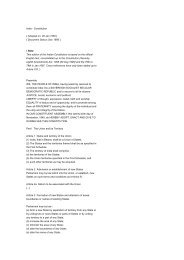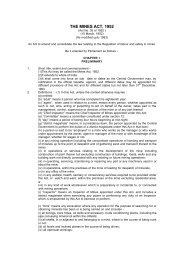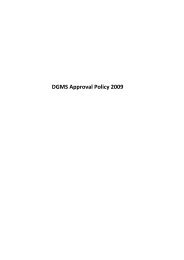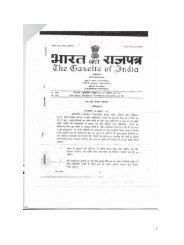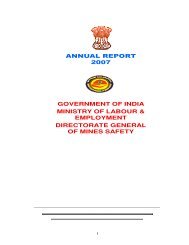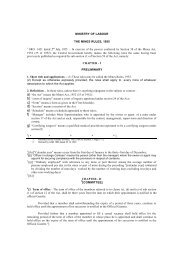Annual Report,2009 - Directorate General of Mines Safety
Annual Report,2009 - Directorate General of Mines Safety
Annual Report,2009 - Directorate General of Mines Safety
Create successful ePaper yourself
Turn your PDF publications into a flip-book with our unique Google optimized e-Paper software.
DGMS <strong>Annual</strong> <strong>Report</strong>, <strong>2009</strong><br />
ventilation <strong>of</strong> heading and sinking shafts; standards <strong>of</strong> ventilation; ventilation<br />
calculation.<br />
Ventilation planning :- Ventilation layout; determination <strong>of</strong> size <strong>of</strong> shafts and<br />
airways; estimation <strong>of</strong> air quantity requirements; ventilation network analysis; Hardy<br />
Cross methods <strong>of</strong> iterative analysis and application <strong>of</strong> linear theory; thermodynamic<br />
network analysis and computer application; application <strong>of</strong> numerical modeling;<br />
estimation <strong>of</strong> pressure requirement; ventilation survey; recent development in mine<br />
ventilation, ventilation plans.<br />
Airbone dust :- Generation, dispersion, measurement and control; suppression<br />
and treatment <strong>of</strong> mine dust; properties <strong>of</strong> stone dust; sampling and analysis <strong>of</strong> mine<br />
dust.<br />
Mine fires:- Cause <strong>of</strong> mine fires, spontaneous combustion, mechanism and<br />
susceptibility indices detection and prevention <strong>of</strong> spontaneous heating and mine fires;<br />
dealing with mine fires; sealing <strong>of</strong>f fire-areas; build-up <strong>of</strong> extinctive atmosphere;<br />
pressure balancing; fire fighting organization; gas ratios and their limitations;<br />
modified gas ratios; reopening <strong>of</strong> sealed <strong>of</strong>f fire areas; fires in quarries over developed<br />
pillars; coal stack and waste dump fires.<br />
Mine explosions :- Fire damp and coal dust explosions; cause and prevention;<br />
stone dust barrier; water barrier and other methods.<br />
Explosion in quarries over developed pillars. Water gas explosion.<br />
Inundation :- Causes and prevention; precautions and techniques <strong>of</strong><br />
approaching old water logged working; safety boring apparatus; pattern <strong>of</strong> hole;<br />
design and construction <strong>of</strong> water dams; water lodgements; monsoon preparations,<br />
water danger plan.<br />
Recovery <strong>of</strong> mine after explosion, fires and inundation rescue and recovery in<br />
mines; rescue apparatus; organization <strong>of</strong> rescue work; emergency preparedness and<br />
response system.<br />
Illumination :- Cap lamps, layout and organization <strong>of</strong> lamp rooms; standards<br />
<strong>of</strong> illumination; photometry and illumination survey.<br />
Risk Assessment and analysis with reference to mine environment,<br />
management <strong>of</strong> environmental risks.<br />
(d)<br />
Mining Machinery and Electricity<br />
Theory <strong>of</strong> Machines :- Machine design, different types <strong>of</strong> gears and drives,<br />
bearing, collars and joints, brakes and friction clutches, governors.<br />
Heat engines, general outline <strong>of</strong> working principles <strong>of</strong> steam generators and<br />
auxiliary equipment, condensing plant, reciprocating steam engines, turbines, internal<br />
combustion engines, conduct <strong>of</strong> gas, oil and steam engine trial; mechanical efficiency<br />
<strong>of</strong> engines, measurement <strong>of</strong> indicated and brake horsepower.<br />
Machine tools and workshop processes:-<br />
Wire ropes :- Construction details, applications, mechanical properties,<br />
breaking load, factor <strong>of</strong> safety bending factor, capacity factor, snap length, critical<br />
depth inspection; examination and discarding criteria; rope capping and splicing.<br />
Mine winders :- Types and applications components; shaft fitting; drums and<br />
sheaves; ropes and guides; drives and control systems; automatic contrivances;<br />
brakes; cage; skip; counter weight and suspension arrangement; duty cycle diagram;<br />
winder capacity and motor power calculations; equivalent mass <strong>of</strong> winder installation;<br />
safety devices; Installation; examination and testing <strong>of</strong> winding equipment, non<br />
destructive testing.<br />
141





